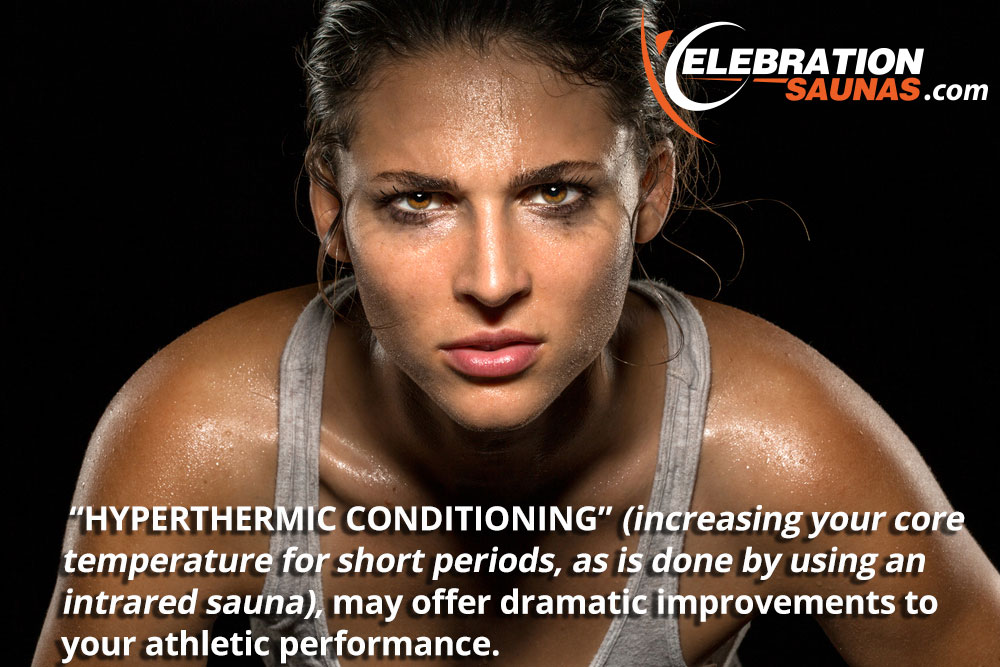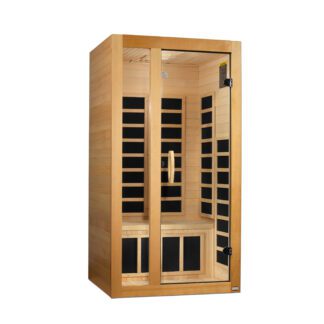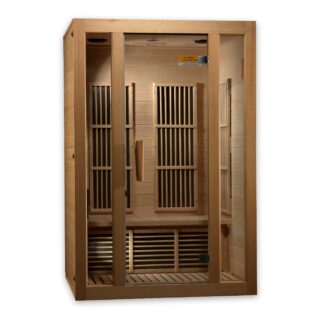Saunas aren’t just being used by athletes for the post-workout muscle relaxation as you might expect. Emerging research on a concept called “Hyperthermic Conditioning” suggests that increasing your core temperature for short periods, as is done by using a sauna, may offer dramatic improvements to your athletic performance.
 Perhaps it’s not a coincidence that exercise, done at high intensity, will increase your body temperature, and will also build your endurance each session. “Hyperthemic Conditioning”, or “adapting yourself to heat independent of aerobic physical activity through sauna use,” also increases stamina because it supports changes in your body that make it easier for you to perform when your body temperature is raised. So, as your body is exposed to reasonable quantities of heat stress, it gradually becomes acclimated to the heat, resulting in many positive changes in your body.
Perhaps it’s not a coincidence that exercise, done at high intensity, will increase your body temperature, and will also build your endurance each session. “Hyperthemic Conditioning”, or “adapting yourself to heat independent of aerobic physical activity through sauna use,” also increases stamina because it supports changes in your body that make it easier for you to perform when your body temperature is raised. So, as your body is exposed to reasonable quantities of heat stress, it gradually becomes acclimated to the heat, resulting in many positive changes in your body.
These changes include increased plasma volume and blood flow to your heart and muscles (which increase athletic endurance and stamina) along with amplified muscle mass because of greater levels of heat-shock proteins and growth hormone.
Fact: Hyperthermic Conditioning increases muscle mass. This happens via three mechanisms:
- The induction of Heat Shock Proteins (“HSP”).
- The induction of Human Growth Hormone (“HGH”).
- By improving insulin sensitivity.
Heat Shock Proteins are activated by the stress put on the body by heat. This is a good example of “hormesis”, a biological phenomenon whereby a beneficial effect (improved health, stress tolerance, growth or longevity) results from exposure to low doses of an agent that is otherwise toxic or lethal when given at higher doses.
The stress response from the heat increases the expression of genes that can deal with it, which are the HSP. They repair the proteins damaged by the heat, prevent oxidative stress, and improve glutathione recycling.
Given this, HSP can cause a net increase in protein synthesis, which is necessary to maintain, or increase muscle mass. The workforce load of the exercise stresses and breaks down muscle tissue; the protein synthesis is necessary to build it back up and make the muscle larger and stronger.
With “Hyperthemic Conditioning” via the sauna, the body develops a higher expression of HSP even under normal temperatures caused by exercise, resulting in an increased capacity for the body to favorably respond to the exercise. The stress that heat puts on your body activates a type of protein that ultimately can increase muscle mass.
FACT: Hyperthermic Conditioning Increases Human Growth Hormone. Human Growth Hormone can be increased by sauna use, and it facilitates muscle growth through:
- IGF-1 (“Insulin Growth Factor 1), a protein that has an anabolic effect, by increasing mTOR (a type of protein that regulates cell growth, proliferation, motility and survival).
- Decreasing protein degradation by activating so-called FOXO genes that regulate expression of genes involved in cell cycle arrest, apoptosis, DNA repair and oxidative stress resistance.)
The effects of sauna use on HGH are dependent on:
- Time in the sauna,
- Frequency, and
- Temperature
HGH can be increased two fold over baseline by two back-to-back 20-minute sauna sessions at 176 degrees Fahrenheit (80 degrees Celcius).
If that’s insufficient, you can get more extreme. Two one-hour sauna sessions separated by at 30 minute cooling off period for three consecutive days increased HGH expression over baseline by 16 fold!
Some people find the aforementioned practice uncomfortable. In contrast, far-infrared saunas (FIRS) heat to 40–60°C and provide a more comfortable and relaxing experience (Beever 2009). These saunas utilize 120-V infrared elements, similar to the infrared warmers on neonatal resuscitation beds, to radiate heat with a wavelength of around 10 µm. As infrared heat penetrates more deeply (approximately 3–4 cm into fat tissue and the neuromuscular system) than warmed air (only a few millimeters), users develop a more vigorous sweat at a lower temperature than they would in traditional saunas. Consequently, the cardiovascular demand imparted by thermoregulatory homeostasis (sweating, vasodilation, decreased afterload, increased heart rate, and increased cardiac output) is aerobically very light (Beever 2009). Study: Effects of far-infrared sauna bathing on recovery from strength and endurance training sessions in men
Human growth hormone (HGH) is a synergistic, foundational biochemical that addresses the serious muscle loss and atrophy that typically occurs with aging. The higher your levels of HGH, the healthier and stronger you will be.
Once you hit the age of 30, you enter what’s called “somatopause,” at which point your levels of HGH begin to drop off quite dramatically. This decline of HGH is part of what drives your aging process, so maintaining your HGH levels gets increasingly important with age.
Some athletes choose to inject HGH for its performance-enhancing potential, though it is a banned substance in nearly every professional sport. However, injecting HGH can be dangerous due to the potential side effects and its potential to cause more long-term harm than good.
Besides, taking such risks is unnecessary because there are ways to naturally optimize your HGH, such as high-intensity exercise and intermittent fasting. Now, you can add “Hyperthemic Conditioning” as another complementary strategy.
The release of HGH is just one way that “Hyperthemic Conditioning” increases muscle growth. It also reduces the amount of protein degradation that naturally occurs during both muscle use and disuse. As a result, this increases the net protein synthesis in your muscles, which ultimately promotes muscle growth.
Interestingly, one of the mechanisms by which heat stress prevents protein degradation is by triggering heat shock proteins (HSPs), which are used by your cells to counteract potentially harmful stimulus. Whenever a cell is exposed to an unfriendly environment, the DNA separates in certain regions and begins to read the genetic code to produce these stress proteins.

FACT: Hyperthermic Conditioning Supports Complete Muscle Recovery After An Injury.
Heat treatments induce heat shock proteins that help protect against rhabdomyolysis, a serious degenerative muscle tissue condition that is one of the most common side effects associated with the use of statin cholesterol-lowering drugs!12 If you’ve had a muscle injury, you may be immobilized for lengthy periods, which generally will cause your muscles to begin to atrophy. “Hyperthermic Conditioning” has been shown to slow muscle atrophy during disuse by up to 32 percent in one animal study. Whole-body heat treatment both prevents muscle atrophy and increases muscle regrowth, courtesy of elevated HSP levels.
FACT: Hyperthermic Conditioning Increases Cardiovascular Conditioning.
Regular use of infrared sauna conditions your body to accommodate high increased temperatures and the resulting stress response. This has a carryover effect when your body’s temperature increases through exercise, because blood flow to the muscles improves, which increases nutrient uptake to muscles, and better glucose and oxygen transport to muscle cells.
In addition, Hyperthermic Conditioning:
- Improves endurance training outcomes because muscles rely less on local glycogen stores;
- Increased blood flow to the heart improves cardiovascular conditioning, as it lowers the heart rate required for the same workload;
- Allows improved heat acclimation so your body begins to sweat at a lower core body temperature.
You get all these benefits from 30 minutes sitting in a sauna twice a week. After about six weeks of such heat work, runners experienced a 32% increase in the distance they could run before exhaustion, and that corresponded with a 7% increase in plasma volume and a corresponding 3.5% increase in their red blood cell count which is thought to be a compensation for increased plasma volume.
Want to find out more? Dr. Rhonda Patrick knows hot saunas. She has a PhD in biomedical science, a Bachelor’s of Science degree in biochemistry/chemistry, has done extensive research on aging, cancer, and nutrition, did her graduate research on the link between mitochondrial metabolism, apoptosis, and cancer. Dr. Patrick is currently a postdoctoral fellow at Children’s Hospital Oakland Research Institute, where she conducts clinical trials looking at the effects of micronutrients (e.g. vitamins and minerals) on metabolism, inflammation, DNA damage, and aging. In addition, she is investigating the role of vitamin D in brain function and other physiological functions. She has also done research on anti-aging techniques at the Salk Institute for Biological Sciences. She can transfix you with the studies indicating that consistent use of saunas can result in improvements in cardiovascular conditioning; muscle mass; memory and neuronal activity; and longevity.




